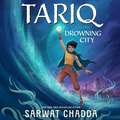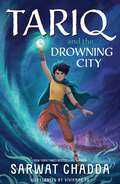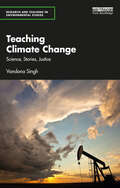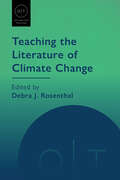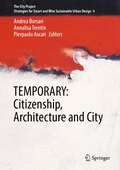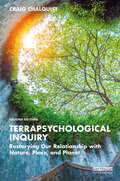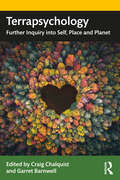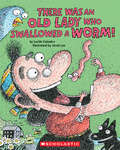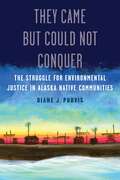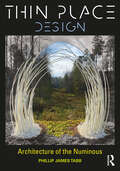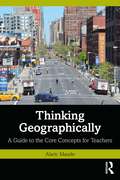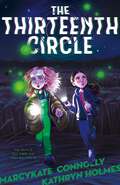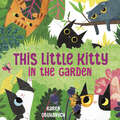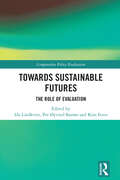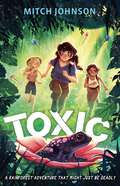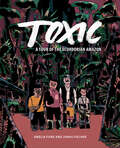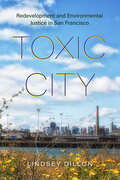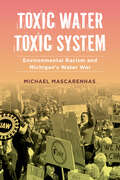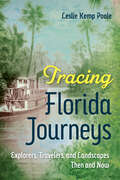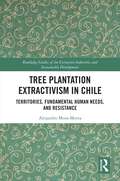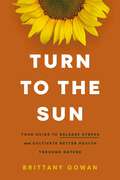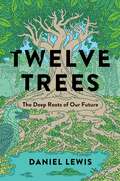- Table View
- List View
Tariq and the Drowning City: Book 1 (The Spiritstone Saga)
by Sarwat ChaddaThe first story in an action-packed fantasy trilogy, perfect for fans of Dungeons and Dragons aged 9+Time is running out. When crops fail and a new plague spreads across the land of Osha, Tariq has a troubling vision - an ancient prophesy is coming true. He travels to the capital city of Ethrial to warn the leaders of an impending flood, but no one listens. It's up to the seer and his new friends, an elf scientist and a dwarf soldier, to take matters into their own hands. Venturing off on an epic quest, the unlikely trio must find a magical moonstone and use its powers to prevent a tidal wave from wiping out the city. But they aren't the only ones seeking to find the moonstone . . . and not everyone wants to use its ancient powers to save Ethrial . . .This pacy adventure blends themes of classic fantasy, Indian mythology, climate emergency and steampunk imagery to create a richly imagined world.
Tariq and the Drowning City: Book 1 (The Spiritstone Saga)
by Sarwat ChaddaDriven from their home by drought and disease, Tariq and his river tribe travel to the great capital city of Ethrial. But once they arrive, Tariq realises that they are still in grave danger - and time is running out! Tariq is a seer, and he's had a troubling vision of a tidal wave that will drown the whole city. But when Tariq warns of impending disaster, he is banished from the city. The only ones who believe Tariq are Livia, and elf inventor, and Artos, the soldier who arrests him. An ancient legend called The Saga of the Spiritstones might hold the key to preventing a disaster. Can Tariq and his new friends find a long-lost Spiritstone and use its powerful elemental magic to save Ethrial, and the people they love, from complete devastation?
Teaching Climate Change: Science, Stories, Justice (Research and Teaching in Environmental Studies)
by Vandana SinghTeaching Climate Change: Science, Stories, Justice shows educators how climate change can be taught from any disciplinary perspective and in a transdisciplinary way, drawing on examples from the author's own classroom. The book sets out a radical vision for climate pedagogy, introducing an innovative framework in which the scientific essentials of climate change are scaffolded via three transdisciplinary meta-concepts: Balance/Imbalance, Critical Thresholds and Complex Interconnections. Author Vandana Singh grounds this theory in practice, drawing on examples from her own classroom to provide implementable ideas for educators, and to demonstrate how climate change can be taught from any disciplinary perspective in a transdisciplinary way. The book also explores the barriers to effective climate education at a macro level, focusing on issues such as climate misinformation/misconception, the exclusion of social and ethical concerns and a focus on technofixes. Singh uses this information to identify four key dimensions for an effective climate pedagogy, in which issues of justice are central: scientific-technological, the transdisciplinary, the epistemological and the psychosocial. This approach is broad and flexible enough to be adapted to different classrooms and contexts. Bridging the social and natural sciences, this book will be an essential resource for all climate change educators practicing in both formal and informal settings, as well as for community climate activists.
Teaching the Literature of Climate Change (Options for Teaching)
by Debra J. RosenthalOver the past several decades, writers such as Margaret Atwood, Paolo Bacigalupi, Octavia E. Butler, and Kathy Jetn̄il-Kijiner have explored climate change through literature, reflecting current anxieties about humans' impact on the planet. Emphasizing the importance of interdisciplinarity, this volume embraces literature as a means to cultivate students' understanding of the ongoing climate crisis, ethics in times of disaster, and the intrinsic intersectionality of environmental issues.Contributors discuss speculative climate futures, the Anthropocene, postcolonialism, climate anxiety, and the usefulness of storytelling in engaging with catastrophe. The essays offer approaches to teaching interdisciplinary and cross-listed courses, including strategies for team-teaching across disciplines and for building connections between humanities majors and STEM majors. The volume concludes with essays that explore ways to address grief and to contemplate a hopeful future in the face of apocalyptic predictions.
TEMPORARY: Citizenship, Architecture and City (The City Project #4)
by Andrea Borsari Annalisa Trentin Pierpaolo AscariThis book offers a comprehensive overview of forces shaping urban renewal and the sustainable and inclusive transformation of contemporary cities. It discusses temporariness and uncertainty of citizenship, participation, and inclusion, as well as the energy and digital transformation, merging different perspectives, such as the social, philosophical, economic, and architectural ones. Based on revised and extended contributions to the International Congress “TEMPORARY: Citizenship, Architecture and City", held virtually on November 20-21, 2022, from the University of Bologna, this book offers extensive information and a thought-provoking reading to researchers in architecture, anthropology, social and environmental policy, as well as to professionals and policy makers involved in planning the city of the future.
Terrapsychological Inquiry: Restorying Our Relationship with Nature, Place, and Planet
by Craig ChalquistTerrapsychological Inquiry is a path of storied, imaginative research that takes seriously our intense inner responses to the state of the natural world. This place-rooted approach studies, from the standpoint of lived experience, how the world gets into the heart. Oceans and skies, trees and hills, rivers and soils, and even built things like houses, cities, ports, and planes: How do they show up for us inwardly? How do our moods, feelings, and dreams reflect what happens in the world? Terrapsychological Inquiry evolved over a decade of exploration by graduate students, instructors, ceremonialists, workshop leaders and presenters, and other practitioners of embodied creativity to offer an Earth-honoring mode of storied qualitative inquiry, one that transforms all involved from passive spectators of the doings of the world into active, sensitive participants. Learn how to use this methodology of earthly reenchantment in a variety of settings inside and outside academia and by doing so reenter an animate world. This new edition has been revised throughout and offers fresh insights into how Terrapsychological Inquiry, a field with roots in depth psychology, ecopsychology, and Hermetic philosophy, can also be used as an ecospiritual path. Thoroughly updated with a new chapter and added discussion questions and exercises at the end of each chapter, this introduction to an evolving research methodology will be of great interest to students and scholars of environmental psychology, ecotherapy, and environment and sustainability studies more generally.
Terrapsychology: Further Inquiry into Self, Place and Planet
by Craig Chalquist Garret BarnwellReflecting on and exploring the connection between the environments in which we live and our moods, motivations and dreams, this insightful volume takes the growing field of terrapsychology into new and exciting directions. This book draws together a group of contemporary voices in terrapsychology to explore lived topics, such as ecotransference encountered with sacred place, alternative mapping and expressions of solidarities with sacred sites, place dreaming, locianalysis, trans-species encounters, deep genealogy, terraplomacy and Hermeticism. The chapters focus on praxis, demonstrating how each author’s relationship with the more-than-human world has been reenchanted, revealing, remembering and co-creating relationships and community for life to flourish. Co-edited by Craig Chalquist and Garret Barnwell this collection will interest scholars, students and practitioners across a range of fields, including analytical psychology, environment psychology, and cultural anthropology.
Terrapsychology: Further Inquiry into Self, Place and Planet
by Craig Chalquist Garret Barnwell- The place of nature and environment is increasingly recognized in therapeutic theory and practice. - Co-edited by the originator of the theory of Terrapsychology. - Builds on his successful 2020 title, Terrapsychological Inquiry, which we also published.
There Was an Old Lady Who Swallowed a Worm!
by Lucille ColandroCelebrate Earth Day with a twist on the classic song from the bestselling There Was an Old Lady series for kids! You’ll never guess what she’ll swallow next!There was an old lady who swallowed a worm.I don’t know why she swallowed the worm,but she started to squirm!The Old Lady is back and this time she's swallowing a worm, some dirt, a flower, a bee, a bird...and more! This Earth Day-themed twist on the classic rhyme will delight and entertain young readers, both old and new!Also in the There Was an Old Lady series:There Was an Old Lady Who Swallowed a Dragon!There Was an Old Lady Who Swallowed a Shell!There Was an Old Lady Who Swallowed Some Leaves!and more!
They Came but Could Not Conquer: The Struggle for Environmental Justice in Alaska Native Communities
by Diane J. PurvisAs the environmental justice movement slowly builds momentum, Diane J. Purvis highlights the work of Indigenous peoples in Alaska&’s small rural villages, who have faced incredible odds throughout history yet have built political clout fueled by vigorous common cause in defense of their homes and livelihood. Starting with the transition from Russian to American occupation of Alaska, Alaska Natives have battled with oil and gas corporations; fought against U.S. plans to explode thermonuclear bombs on the edge of Native villages; litigated against political plans to flood Native homes; sought recompense for the Exxon Valdez oil spill disaster; and struggled against the federal government&’s fishing restrictions that altered Native paths for subsistence. In They Came but Could Not Conquer Purvis presents twelve environmental crises that occurred when isolated villages were threatened by a governmental monolith or big business. In each, Native peoples rallied together to protect their land, waters, resources, and a way of life against the bulldozer of unwanted, often dangerous alterations labeled as progress. In this gripping narrative Purvis shares the inspiring stories of those who possessed little influence over big business and regulations yet were able to protect their traditional lands and waterways anyway.
Thin Place Design: Architecture of the Numinous
by Phillip James TabbWhat makes the places we inhabit extraordinary? Why are some urban spaces more vital and restorative? Wonderful landscapes, inspiring works of architecture and urban design, and the numinous experiences that accompany them have been an integral dimension of our culture. Up-lifting spaces, dramatic use of natural light, harmonic proportional geometry, magical landscapes, historic sites and vital city centers create special, even sacred moments in architecture and planning. This quality of experience is often seen as an aesthetic purpose intended to inspire, ennoble, ensoul and spiritually renew. Architecture and urban spaces, functioning in this way, are considered to be thin places.
Thinking Geographically: A Guide to the Core Concepts for Teachers
by Alaric MaudeThis book explains how the concepts of geography can teach young people to think geographically, deeply and ethically. Thinking Geographically demonstrates how the concepts of place, space, environment and interconnection teach students new ways of perceiving and understanding the world, the concepts of scale and time teach them ways of analysing the world, while the concepts of sustainability and wellbeing show them how to evaluate and reflect on what they observe, and all eight concepts develop their higher order and critical thinking. To further support teachers, this book includes a chapter on how to teach for conceptual understanding, as well as two chapters that illustrate the application of geographical thinking to an understanding of the effects of land cover change and the problem of regional inequality. Rich with practical examples, this book is an essential resource for geography teachers, whether already teaching or studying to become one, and for those who teach therm.
The Thirteenth Circle
by MarcyKate Connolly Kathryn HolmesThe X-Files meets Scooby-Doo in THE THIRTEENTH CIRCLE, a middle-grade mystery from MarcyKate Connolly and Kathryn Holmes, featuring two unexpected friends, crop circles, science fairs, and Men in Black, perfect for both the highly scientific and cryptid enthusiasts alike.Cat knows aliens are real, and she’s determined to prove it. By studying the Weston Farm Circles, her town’s legendary crop circle phenomenon, she’ll not only demonstrate the existence of extraterrestrial life, but also win the grand prize in the McMurray Youth Science Competition—a feat she’s sure will impress her distant NASA scientist father.Dani most certainly does not believe in aliens. How can she, when they go against every scientific principle she’s been taught? So when Dani is paired with Cat to enter the McMurray Youth Science Competition—which she has to win to avoid going to her parents’ artsy summer camp—she knows she’s at a disadvantage. Her solution? Disprove Cat’s theory, of course . . . without telling her partner her true intentions.But as the girls bond over science, it becomes clear that there is something strange about the Weston Farm Circles. And when Dani and Cat’s project is threatened by suspicious forces, they’ll have to work together to expose the truth, once and for all.
This Little Kitty in the Garden
by Karen ObuhanychSpring is blooming, and what better way for rascally kittens to celebrate than by causing mischief in the garden in this charming picture book!Spring has sprung on Sakura Way.The five little kittles will garden today!Read along as these frisky felines plant seeds, pounce and play, claw and climb, and splish, splash and swirl—until they end their day asleep in the garden bed. Filled with bright and playful illustrations, here is an adorable picture book that introduces kids to the wonders of spring as they spend time in the garden with these delightful cats—all brimming with cattitude. Here is a picture book sure to charm cat lovers and kids alike.
Total Garbage: How We Can Fix Our Waste and Heal Our World
by Edward HumesAn investigative narrative that dives into the waste embedded in our daily lives—and shows how individuals and communities are making a real difference for health, prosperity, quality of life and the fight against climate change, by a Pulitzer Prize winning journalistWhat happens to our trash? Why are our oceans filling with plastic? Do we really waste 40 percent of our food 65 percent of our energy? Waste is truly our biggest problem, and solving our inherent trashiness can fix our economy, our energy costs, our traffic jams, and help slow climate change—all while making us healthier, happier and more prosperous. This story-driven and in-depth exploration of the pervasive yet hard-to-see wastefulness that permeates our daily lives illuminates the ways in which we've been duped into accepting absolutely insane levels of waste as normal. Total Garbage also tells the story of individuals and communities who are finding the way back from waste, and showing us that our choices truly matter and make a difference. Our big environmental challenges – climate, energy, plastic pollution, deforestation, toxic emissions—are often framed as problems too big for any one person to solve. Too big even for hope. But when viewed as symptoms of a single greater problem—the epic levels of trash and waste we produce daily--the way forward is clear. Waste is the one problem individuals can positively impact—and not just on the planet, but also on our wallets, our health, and national and energy security. The challenge is seeing our epic wastefulness clearly. Total Garbage will shine a light on the absurdity of the systems that all of us use daily and take for granted--and it will help both individuals and communities make meaningful changes toward better lives and a cleaner, greener world.
Towards Sustainable Futures: The Role of Evaluation (Comparative Policy Evaluation)
by Ida Lindkvist Per Øyvind Bastøe Kim ForssTowards Sustainable Futures serves as a guide to better understand what roles evaluation can play in sustainability. Rather than proposing a single definition of sustainability or methodological approach, this book gives us the tools to improve the quality and relevance of evaluation of sustainability. Divided into two parts, the first part introduces the reader to key debates and challenges related to evaluation of sustainability. Part Two provides examples of methods and applications. By combining a stellar line up of specialists, theorists, and practitioners in the field of development evaluation with expert, accessible and engaged analysis of key issues, Towards Sustainable Futures is a must-read source for re-tooling and re-focussing evaluation towards the green transition imperative. It should be essential reading for scholars and practitioners of evaluation.
Toxic: A rainforest adventure that might just be deadly.
by Mitch JohnsonHidden in the heart of the rainforest lies a secret... can three friends survive long enough to find it? An action-packed jungle adventure, perfect for fans of Katherine Rundell's The Explorer and M.G. Leonard's Twitch.Billionaire beauty mogul Anura Hegarty has pledged to acquire as much of the rainforest as possible to preserve it. But when armed guards appear and bring in portable terrariums to capture wildlife, Jessica and her friend Renata realise something much more sinister is going on.The rainforest holds a frog with a secret to staying young forever, and Jessica and Renata know they must find and save it first! Together with Briony-Rose, the girls journey deeper into the rainforest. Danger and betrayal lurk in every corner, and soon they're running for their lives, dodging blow darts and falling into traps. Will the children make it out of the forest alive?Praise for Mitch Johnson'Fizzes with adventure and great characters who pop from the page' - Peter Bunzl, bestselling author of Cogheart'I read it all in one gulp!' - Ross Welford, bestselling author of Time Travelling with a Hamster'A bonkers Willy-Wonka nightmare designed to get children thinking about the effects of everything they buy' - Ross Montgomery, bestselling author of The Midnight Guardians'A zany adventure that will make you bubble with laughter and fizz with indignation on behalf of our planet' - Maria Kuzniar, bestselling author of The Ship of Shadows'An exploding soda geyser of a book - an adventure story that will make you laugh, make you angry and make you want to do something to fix this crazy, messed up world' - Charlie Higson, bestselling author of Young Bond and The Enemy'Pop! is an explosive and unforgettable adventure with defiant heroes, devious villains, deadly corporate secrets all told with Johnson's brilliant humour. I loved it' - Tamsin Winter, bestselling author of Jemima Small Versus the Universe
Toxic: A Tour of the Ecuadorian Amazon (ethnoGRAPHIC)
by Amelia Fiske Jonas FischerOver the past decade, people have learned about oil contamination in the Ecuadorian Amazon through toxic tours in which a guide brings participants – students, lawyers, environmental activists, journalists, and foreign tourists – to visit contaminated sites. These toxic tours combine personal experience and local knowledge to convince visitors of the immediacy of environmental issues. Drawing on extensive research and fieldwork, Toxic takes the reader on a visual toxic tour through the Amazon. Following the story of three fictional participants, this graphic novel paints a visceral picture of the waste pits, gas flares, and precarious lives of people in this region. The book challenges the reader to consider what it means to live in a place and historical moment where victims of industrial toxicants are continually required to prove that harm has occurred. Toxic is a vivid reflection on the role of pollutants in our everyday lives, ultimately asking readers to reflect on how we are each implicated in the production, consumption, and exposure of pollution both in the Amazon and at home.
Toxic City: Redevelopment and Environmental Justice in San Francisco
by Lindsey DillonToxic City presents a novel critique of postindustrial green gentrification through a study of Bayview-Hunters Point, a historically Black neighborhood in San Francisco. As cities across the United States clean up and transform contaminated waterfronts and abandoned factories into inviting spaces of urban nature and green living, working-class residents—who previously lived with the effects of state abandonment, corporate divestment, and industrial pollution—are threatened with displacement at the very moment these neighborhoods are cleaned, greened, and revitalized. Lindsey Dillon details how residents of Bayview-Hunters Point have fought for years for toxic cleanup and urban redevelopment to be a reparative process and how their efforts are linked to long-standing struggles for Black community control and self-determination. She argues that environmental racism is part of a long history of harm linked to slavery and its afterlives and concludes that environmental justice can be conceived within a larger project of reparations.
Toxic Water, Toxic System: Environmental Racism and Michigan's Water War
by Prof. Michael MascarenhasThe tireless resistance of local communities fighting for ownership of America’s third largest water system Toxic Water, Toxic System exposes the consequences of a seemingly anonymous authoritarian state willing to maintain white supremacy at any cost—including poisoning an entire city and shutting off water to thousands of people. Weaving together narratives of frontline activists along with archival data, Michael Mascarenhas provides a powerful exploration of the political alliances and bureaucratic mechanisms that uphold inequality. Drawing from three years of ethnographic fieldwork in Flint and Detroit, this book amplifies the voices of marginalized communities, particularly African American women, whose perspectives and labor have been consistently overlooked. Toxic Water, Toxic System offers a fresh perspective on the ties between urban austerity policies, environmental harm, and the advancement of white supremacist agendas in predominantly Black and brown cities.
Tracing Florida Journeys: Explorers, Travelers, and Landscapes Then and Now (Co-published with Florida Humanities)
by Leslie Kemp PooleDiscover Florida’s unique places across time through writings from history How has Florida’s land changed across five centuries? What has stayed the same, and what remains only in memory? In Tracing Florida Journeys, Leslie Poole delves into the stories of well-known explorers and travelers who came to the peninsula and wrote about their experiences, looking at their words and the paths they took from the perspective of today. In these pages, John Muir and Harriet Beecher Stowe write about their visits to Florida, reflecting their expectations of a place that was touted to be “paradise.” John James Audubon finds riches of bird life in the Keys. Zora Neale Hurston travels to turpentine camps and sawmills documenting the stories and music of workers and residents. Jonathan Dickinson and Stephen Crane recount shipwrecks along a sparsely populated coastline. Members of Hernando de Soto’s violent 1539 expedition of conquest describe their struggles with dense swamps, forests, and rivers, and resistance from the Native people they exploited. Using journals and articles by these and other authors that date back to the early European exploration of the region, Poole retraces their steps. The land they write about is often hard to imagine in today’s Florida, a top destination for tourists filled with almost 22 million residents. These stories show the evolving history of the state and the richness of its natural resources. Poole’s comparisons also point to the people who have been displaced and the ecosystems that have been dramatically altered by exploration and development. Highlighting the Florida that was and the Florida that exists now, Poole brings together historical research, interviews with experts, and her personal experiences to tell a revealing story of the state’s natural history. Funding for this publication was provided through a grant from Florida Humanities with funds from the National Endowment for the Humanities. Any views, findings, conclusions or recommendations expressed in this publication do not necessarily represent those of Florida Humanities or the National Endowment for the Humanities.
Tree Plantation Extractivism in Chile: Territories, Fundamental Human Needs, and Resistance (Routledge Studies of the Extractive Industries and Sustainable Development)
by Alejandro Mora-MottaThis book examines how extractivism transforms territories and affects the well-being of rural people, drawing on in-depth fieldwork conducted on tree plantations in Chile.The book argues that pine and eucalyptus monoculture plantations in southern Chile are a form of extractivism representing a mode of nature appropriation that captures large amounts of natural resources to produce wooden-based raw materials with little processing and an export-oriented focus. The book discusses the nexus of extractivism, territorial transformations, well-being, and emerging resistances using a participatory action research methodological approach in the Region of Los Ríos, southern Chile. The findings show how the configuration of an extractivist logging enclave generated a substantial and irrevocable reordering of human-nature relations, resulting in the territorial and ontological occupation of rural places that disrupted the fundamental human needs of peasants and indigenous people. The book maintains that Chile's green growth development approach does not challenge the consolidated tree plantation enclave controlled by large multinationals. Instead, green growth legitimises the extractivist logic. The book draws parallels with other countries and regions to contribute to wider debates surrounding these topics.This book will be of great interest to students and scholars of the extractive industries, development studies, political ecology, and natural resource governance.
Turn to the Sun: Your Guide to Release Stress and Cultivate Better Health Through Nature
by Brittany GowanTurn to the Sun guides you down a nourishing path of uplifting affirmations, soul-refreshing meditations, and lush botanical photography that helps you heal in the company of nature. Approach your days with less anxiety, renewed vigor, and a deeper sense of well-being as you become grounded and soak up nature's restorative qualities.Whether you live in an urban jungle, on a suburban cul-de-sac, or at the edge of a national forest, you might find yourself more connected to technology than to nature. In the midst of the pings and rings of a device-dependent life, is getting close to nature even possible—or worth it?Wellness coach and the founder of Pause with Plants Brittany Gowan shows you how slowing down, unplugging, and connecting with the natural world is not only possible and absolutely worth it, but also essential. Brittany creates a reflective experience enhanced by plants that helps you find the calm and tranquility you crave.In these gorgeous, photo-filled pages, you'll find ways to:Cultivate mindfulness as you let go of daily distractionsLet nature guide you into relishing the present momentUse a nature-focused mindset to persist through challengesConnect and ground yourself with nature anywhere, anytimeNourish your relationship with yourself and the world around you Turn to the Sun includes:Affirmations: simple statements that have a positive effect on your thoughts and actionsMeditations: guidance for reflection and contemplation to center your mind and bodyHow-tos: doable exercises to fully engage with the natural worldStunning botanical photography: lush images of plants that pair with affirmations, meditations, and how-tos When in your life have you felt most alive? You can feel that way again. You can flourish, with purpose, whether you are in a waiting season or ready to blossom. It's time to pause. It's time to breathe. It's time to grow.
Twelve Trees: The Deep Roots of Our Future
by Daniel LewisA compelling global exploration of nature and survival as seen via a dozen species of trees that represent the challenges facing our planet, and the ways that scientists are working urgently to save our forests and our future.The world today is undergoing the most rapid environmental transformation in human history—from climate change to deforestation. Scientists, ethnobotanists, indigenous peoples, and collectives of all kinds are closely studying trees and their biology to understand how and why trees function individually and collectively in the ways they do. In Twelve Trees, Daniel Lewis, curator and historian at one of the world&’s most renowned research libraries, travels the world to learn about these trees in their habitats. Lewis takes us on a sweeping journey to plant breeding labs, botanical gardens, research facilities, deep inside museum collections, to the tops of tall trees, underwater, and around the Earth, journeying into the deserts of the American west and the deep jungles of Peru, to offer a globe-spanning perspective on the crucial impact trees have on our entire planet. When a once-common tree goes extinct in the wild but survives in a botanical garden, what happens next? How can scientists reconstruct lost genomes and habitats? How does a tree store thousands of gallons of water, or offer up perfectly preserved insects from millions of years ago, or root itself in muddy swamps and remain standing? How does a 5,000-year-old tree manage to live, and what can we learn from it? And how can science account for the survival of one species at the expense of others? To study the science of trees is to study not just the present, but the story of the world, its past, and its future. Note—species include: * The Lost Tree of Easter Island (Sophora toromiro) * The coast redwood (Sequoia sempervirens) * Hymenaea protera [a fossil tree] * The Longleaf pine (Pinus palustris) * East Indian sandalwood (Santanum album) * The Bristlecone pine (Pinus longaeva) * West African ebony (Diospyros crassiflora) * The Tasmanian blue gum eucalyptus (Eucalyptus globulus) * Olive tree (Olea europaea) * Baobab (Adansonia digitata) * the kapok tree (Ceiba pentandra) * The bald cypress (Taxodium distichum)
Two Together (Brendan Wenzel)
by Brendan WenzelIn this companion book to They All Saw a Cat and Inside Cat, a journey home leads to unexpected adventures for a cat and dog. A playful, imaginative story of friendship, empathy, and discovery by Caldecott Honor winner Brendan Wenzel.Cat and Dog are headed home. A simple route lies ahead of them . . . or does it? There’s so much to see and smell and hear, and the two of them experience the world very differently. A stream, for instance, is watery fun for Dog, but it may not be so delightful for Cat!As their journey becomes an adventure full of unexpected twists and turns, Cat and Dog show that it’s possible for two creatures to travel in the world together despite their distinctive perspectives and abilities—and even to appreciate and enjoy them. With the irresistible read-aloud appeal of Brendan Wenzel’s They All Saw a Cat, winner of the Caldecott Honor, this is a funny, exuberant companion tale that’s an imaginative tribute to empathy, friendship, and understanding.RESPECTING DIFFERENCES: Cat and Dog experience life in almost opposite ways. Through their eyes, children will see how the same situation or problem can be handled differently depending on the perspective and ability of the creature living through it, building their empathy and understanding.DELIGHTFUL VISUALS: This picture book is full of visual surprises and Easter eggs, and readers will love turning back to find details that hint at developments to come on the journey. The dog's and cat’s art styles evolve throughout, becoming more developed and exaggerated but ending with a unified style that incorporates both their points of view as their friendship is affirmed and strengthened.ENCOURAGES EXPLORATION: The path home is both a familiar route and a new experience as Cat and Dog make surprising—sometimes unpleasant—discoveries along the way. The subtle message about appreciating the small moments in everyday routines and the possibilities that await when we step outside them is perfect for young readers.BELOVED AUTHOR/ILLUSTRATOR: Brendan Wenzel is a bestselling author, Caldecott Honor–winning artist, and sought-after speaker at schools and libraries. His books They All Saw a Cat, Hello Hello, A Stone Sat Still, and Inside Cat have received multiple awards and starred reviews and are family and classroom favorites.FUN READ-ALOUD BOOK: Rhythmic text coupled with compelling artwork and a comforting ending make this perfect for story time, bedtime, or both!Perfect for:Parents, grandparents, educators, and educatorsPreschool and kindergarten–level readersPet ownersGift givers looking for a fun, interactive family read-aloud bookFans of Brendan WenzelFans of picture books like Hot Dog, The Kissing Hand, What Do You Do With a Problem?, and The Day the Crayons Quit
